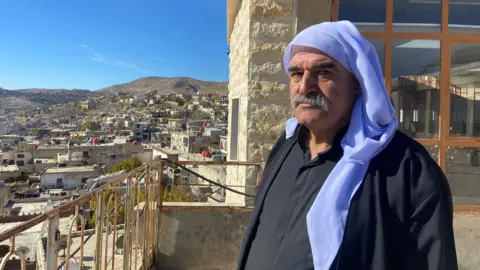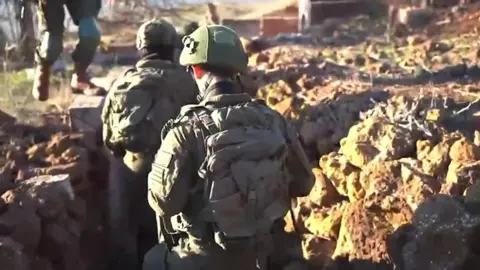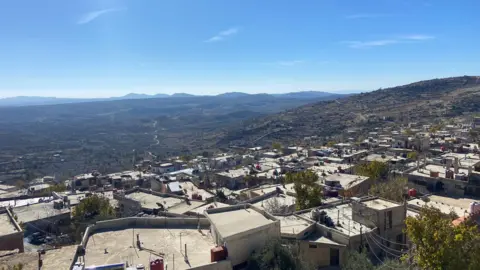 BBC
BBCAn hour’s drive from Damascus, on a country road into the Syrian village of Hadar, we meet Israel’s army.
Two military vehicles and several soldiers in full combat gear man an impromptu checkpoint – a foreign authority in a country celebrating its freedom. They waved us through.
It was evidence of Israel’s incursion into Syrian territory – the temporary seizure, it said, of a UN-monitored buffer zone, set up in a ceasefire agreement 50 years ago.
“Maybe they’ll leave, maybe they’ll stay, maybe they’ll make the area safe then go away,” said Riyad Zaidan, who lives in Hadar. “We want to hope, but we’ll have to wait and see.”
The village chief, Jawdat al-Tawil, pointed to the Golan Heights territory Israel occupied in 1967, clearly visible from Hadar’s terraces.
Many residents here have relatives still living there.
Now, they see Israeli forces routinely moving around their own village, parts of which jut into the demilitarized zone. On a slope above, Israeli bulldozers can be seen working on the hillside.
A week after President Assad’s regime fell, the sense of freedom here comes tinged with fatalism.
Jawdat al-Tawil told me proudly how the village had defended itself against militia groups during the Syrian civil war, and showed me portraits of the dozens of men who had died doing so.
“We don’t allow anyone to transgress on our land,” he said. “[But] Israel is a state – we can’t stand against it. We used to stand up to individuals, but Israel is a super-power.”
 IDF
IDFSince the fall of Syria’s former president Bashar al-Assad earlier this month, Israel has also carried out hundreds of airstrikes on military targets across Syria.
And Israel’s Prime Minister Benjamin Netanyahu has announced new plans to double the population of Israeli settlements in the occupied Golan Heights, saying the move was needed because of “the new front” that had opened up in Syria.
Speaking before that plan was unveiled, Syria’s interim leader Ahmed al-Sharaa warned Israel’s military manoeuvres risked unwarranted escalation in the region and said his administration did not want conflict with Israel.
The Israeli Foreign Ministry said its actions were necessary because of threats posed by jihadist groups operating along the ceasefire line with Syria, describing its military incursions there as “limited and temporary”.
The residents of Hadar belong mainly to the Druze community – a tight-knit, introverted group which splintered from mainstream Shia Islam centuries ago.
When Israel occupied part of the Golan Heights in the 1967 war, and later unilaterally annexed it, some of the Druze there opted to remain and take Israeli citizenship.
Al-Sharaa, the leader of the Syrian militia Hayat Tahrir al-Sham (HTS) that forced President Assad from power this month, has his family roots in the occupied Golan Heights.
Some here on the Syrian-controlled side fear Israel’s plan is to grab more territory for itself.
For years, Israel has been battling the Iran-backed militia there that supported Assad. This border region is a key weapons-supply route between Tehran and the proxy forces it maintains, including the Lebanese militia Hezbollah.
Assad’s fall has left those groups – and Iran – weaker. But Israel has since stepped up its military campaign, taking advantage of the political vacuum to extend its reach.
It has also been targeting military equipment left by Assad’s forces at bases across the country, worried about who might end up using it in the future.
Israel’s Defence Minister, Israel Katz, said on Sunday that the “immediate risks” to Israel remained, and the recent developments in Syria had increased the threat, “despite the moderate appearance that rebel leaders claim to present”.
Marginalised by the Assad regime, and targeted as infidels by Sunni jihadist groups like HTS, Syria’s Druze are more tolerant of Israel than many other communities here.

The village used to fight against the Iran-backed groups Israel sees as a threat here, but Jawdat al-Tawil told me that alliances in the area were shifting, and that he was now talking to these groups about reaching a deal.
Syria is not a place where people have relied on only one ally, or fight only one enemy.
“We just need peace,” resident Riyad Zaidan told me. “We’ve had enough war, enough blood, enough hard life – we need to stop.”
Religious minorities like the Druze suffered under Assad. The country’s new leaders from HTS have promised tolerance and respect for Syria’s diverse ethnic and religious groups.
But eight years ago the group was still aligned with global jihadist groups like al-Qaeda.
It was around the time HTS split from al-Qaeda in 2016 that Jawdat al-Tawil’s son, Abdo, was killed by their militiamen on the outskirts of Hadar, while fighting for the Syrian Army.
He showed me the path where 30-year-old Abdo died and I asked how he felt about HTS taking control of Syria now.
“At first, they were gangs. Now they have got rid of the tyrant [Assad], and have come to power,” he said. “They’re supposed to rule with justice, provide safety and ensure people’s rights.”
“It’s not clear yet if they’ve changed,” he said. “I hope so.”
Additional reporting by Yousef Shomali, Charlotte Scarr and Mayar Mohanna
